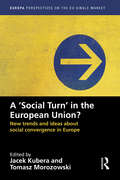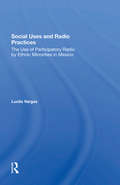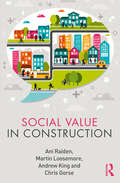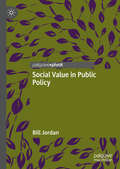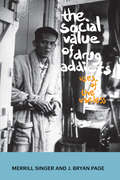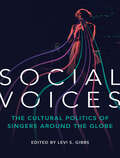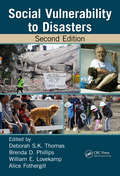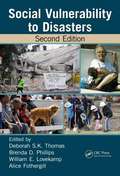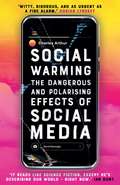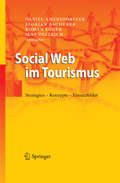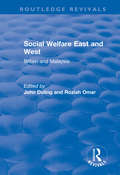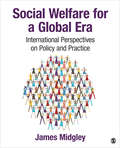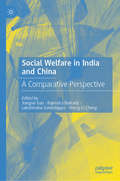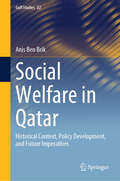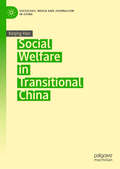- Table View
- List View
Social Trust: Informal Finance and Economic Transformations
by Liu WeipingThis book explores how social trust impacts the Chinese economy. Due to the profound social changes brought by rapid urbanization, China's traditional social trust system gradually weakens. How to rebuild and enhance social credit remains as a key and difficult project. Exploring case studies from the real estate market, private banking, and urban financing, this book explores the value of informal social links to the economic functions of a society and how to rebuild them when they erode. This is of interest to scholars of China's economy and society.
A `Social Turn’ in the European Union?: New trends and ideas about social convergence in Europe (Europa Perspectives on the EU Single Market)
by Jacek KuberaSocial Europe is a key topic in the construction of the EU and its institutions. This volume examines the current state of, and perspectives for, Social Europe, as well as key issues in European social policy, including the posting of workers, the impact of the free market and regulations on social convergence, work automation, digitalisation, taxation and democracy in the workplace. The aim of this volume is to identify a course to be followed in integrating the EU’s social policies and point to areas in which co-operation between member states is likely to produce best results. While a Social Europe was previously seen to be a natural consequence of political and economic integration, it is now viewed as a separate area that requires active policies to preserve the European project. The EU’s big question today concerns the level at which this policy should be pursued: the volume’s contributors outline difficulties with harmonising social policies across the Union, but they nevertheless argue that, owing to the common challenges faced by Europe, the idea of a Social Europe must not be abandoned and requires specific action. The volume consists of 11 chapters written by a variety of expert authors, analysing the idea of a Social Europe and proposing ways in which it could be put into practice. Social policy can no longer be seen as derived from economic policy but rather as a separate driver of development that could be of interest to the northern, southern and eastern states of the EU. Jacek Kubera, PhD, Assistant Professor, Faculty of Sociology, Adam Mickiewicz University in Poznań. Tomasz Morozowski, PhD candidate, Faculty of Political Science and Journalism, Adam Mickiewicz University in Poznań, and analyst at the Poznań Institute for Western Affairs.
Social TV: Multi-Screen Content and Ephemeral Culture
by Cory BarkerWinner of the 2023 SCMS Media Industries Scholarly Interest Group Outstanding Book Award sponsored by the Center for Entertainment & Media IndustriesOn March 15, 2011, Donald Trump changed television forever. The Comedy Central Roast of Trump was the first major live broadcast to place a hashtag in the corner of the screen to encourage real-time reactions on Twitter, generating more than 25,000 tweets and making the broadcast the most-watched Roast in Comedy Central history. The #trumproast initiative personified the media and tech industries’ utopian vision for a multi-screen and communal live TV experience. In Social TV: Multi-Screen Content and Ephemeral Culture, author Cory Barker reveals how the US television industry promised—but failed to deliver—a social media revolution in the 2010s to combat the imminent threat of on-demand streaming video. Barker examines the rise and fall of Social TV across press coverage, corporate documents, and an array of digital ephemera. He demonstrates that, despite the talk of disruption, the movement merely aimed to exploit social media to reinforce the value of live TV in the modern attention economy. Case studies from broadcast networks to tech start-ups uncover a persistent focus on community that aimed to monetize consumer behavior in a transitionary industry period. To trace these unfulfilled promises and flopped ideas, Barker draws upon a unique mix of personal Social TV experiences and curated archives of material that were intentionally marginalized amid pivots to the next big thing. Yet in placing this now-forgotten material in recent historical context, Social TV shows how the era altered how the industry pursues audiences. Multi-screen campaigns have shifted away from a focus on live TV and toward all-day “content” streams. The legacy of Social TV, then, is the further embedding of media and promotional material onto every screen and into every moment of life.
Social Urbanism and the Politics of Violence: The Medellín Miracle
by Kate MacleanMedellin, Colombia, used to be the most violent city on earth, but in recent years, allegedly thanks to its 'social urbanism' approach to regeneration, it has experienced a sharp decline in violence. The author explores the politics behind this decline and the complex transformations in terms of urban development policies in Medellin. "
Social Uses And Radio Practices: The Use Of Participatory Radio By Ethnic Minorities In Mexico
by Lucila VargasThis book is about the social value of participatory or communityoriented radio and stresses how the politics of race, ethnicity, class, and gender shapetheextentand quality of people's participation in development efforts. It shows, ethnographically, how a number of Mexican ethnic minorities use the communication resources made available to them by a network of radio stations sponsored by the federal government through its lnstituto Nacional lndigenista (INI).
Social Value in Construction
by Ani Raiden Martin Loosemore Andrew King Chris GorseWhile the concept of social value is not new, recent interest in social value in construction has grown because of new social procurement legislation around the world and an increasing acceptance of the need to ensure construction projects provide social value, rather than simply economic value. Despite this growing recognition, literature and professional guidance on the subject is hard to find. This is the first book looking at social value in construction and it sets the agenda by asking and answering important questions like: How is the construction industry developing and supporting social enterprise and social value and for who? How and when is the industry recording and measuring social value and its effect? Which organisations are doing things well and what can we learn from their experiences? What can industry players do together to consolidate efforts and drive improvements? What are the key challenges in the field and what does the future look like? Drawing on a variety of professional and academic experiences and disciplines, the authors present global perspectives and lay the foundations for creating social value in the construction industry. This timely book makes use of real-life case studies and examples of best practice to demonstrate how innovative companies can utilise contemporary research to create social value through their projects. It is time the construction industry viewed community involvement and corporate social responsibility as an opportunity rather than a risk, and this is the book that shows the industry how. This is essential reading for all professionals in the construction, engineering, architecture and built environment sector. In particular, project managers, clients, contract managers, quantity surveyors, CSR and HR personnel will gain a lot from reading this book.
Social Value in Public Policy: Social Value In Public Policy
by Bill JordanThis book considers the role of social value in the making and implementation of public policy, taking into account how concepts such as subjective well-being (SWB) can be used to measure the expected impact of enacted policies. It argues that there is no evidence that markets have contributed to greater well-being, and that moments of crisis, such as the COVID-19 pandemic, represent an opportunity to re-orientate policymaking and policy implementation away from those which favour markets, and towards those which place subjective well-being at their core. Following this premise, the author explores the elements that should be considered in a future society that prioritises social value.
The Social Value of Drug Addicts: Uses of the Useless
by Merrill Singer J Bryan PageDrug users are typically portrayed as worthless slackers, burdens on society, and just plain useless—culturally, morally, and economically. By contrast, this book argues that the social construction of some people as useless is in fact extremely useful to other people. Leading medical anthropologists Merrill Singer and J. Bryan Page analyze media representations, drug policy, and underlying social structures to show what industries and social sectors benefit from the criminalization, demonization, and even popular glamorization of addicts. Synthesizing a broad range of key literature and advancing innovative arguments about the social construction of drug users and their role in contemporary society, this book is an important contribution to public health, medical anthropology, popular culture, and related fields.
A Social View of Socotra Island: People, Culture, Heritage
by Nataša Slak Valek Ahmad Abdelmoniem ZedanThis book focuses on Socotra Island, geographically based in Yemen, and aims to explore the island from the social sciences point of view. This book focuses on people indigenous to Socotra, Socotri cultures, heritage and also offers contributions from business, tourism, linguistic, communication, and anthropology. While a lot has been published in natural science about Socotra’s endemic species, biodiversity, and nature in general, social scientific research of the island is very limited. This book addresses therefore addresses this gap and explores various topics of tourism, behaviours, cultures, and language.This book focuses on a clear social science approach of Socotra. The purpose of this book is to publish research about the people, behaviors, heritage, and potential tourism of Socotra. The Socotra Archipelago has long been a land of mystery. It is unknown as a tourism destination for many, however, is a popular destination for adventurers, photographers and travelers who like to travel to remote and undeveloped places. This book explains how Socotra has limited resources of electricity, which is provided by diesel generators, Internet is very slow and limited to certain points on the island. There are no shopping malls or five-star hotels. Roads, schools, and hospitals have been built only recently. This book shoes how these island people do not know the development as we do, which makes it principally interesting to research. Previous interviewers of Socotri people about tourism development in the island have faced many challenges such as language barriers, lack of understanding the meanings and interviewing content, lack of support for the anticipated research results. This book successfully undertakes this challenge as not only in understanding the language, but understanding phenomena like e.g. tourism. Whilst acknowledging the ways in which indigenous island people have never travelled or seen a developed city. Thus, words like ‘developed’, ‘tourism destination’ or ‘washing machine’ may be unfamiliar terms for them. Therefore, new and innovative research methods that are sensitive to Socotra people were implemented in the creation of this book.
Social Virtual Worlds and Their Places: A Geographer’s Guide
by Merrill L. JohnsonThis book provides a foundational look at social virtual worlds from the geographer’s perspective. How can the geographer’s craft be applied to social virtual worlds? This question is addressed through careful analysis of what social virtual worlds are, how interest in these worlds has waxed and waned during the twenty-first century, and the meaning of their concocted spaces. Examining one of the key features of the social virtual world, the avatar, the book focuses on its user's motivations and identity choices. The book draws on the geographical understanding of place to examine where avatars live, work, and roam, and describes how virtual-world places resemble and diverge from actual-world places. A mixed-methods survey conducted in Second Life adds additional breadth to the discussion, whilst a series of vignettes gives extra life to the subject matter. This original exploration of the content and meaning of social virtual worlds is an essential resource for geographers, and for anyone interested in the virtual world experience.
Social Voices: The Cultural Politics of Singers around the Globe
by Jeff Todd Titon Ruth Hellier Anthony Seeger Treva B. Lindsey Nancy Guy Carol Muller Elijah Wald Andrew Simon John Lie Eric Lott Christina D Abreu Carol Silverman Michael K Bourdaghs Kwame Dawes Natalie Sarrazin Katherine MeizelSingers generating cultural identity from K-Pop to Beverly Sills Around the world and across time, singers and their songs stand at the crossroads of differing politics and perspectives. Levi S. Gibbs edits a collection built around the idea of listening as a political act that produces meaning. Contributors explore a wide range of issues by examining artists like Romani icon Esma Redžepova, Indian legend Lata Mangeshkar, and pop superstar Teresa Teng. Topics include gendered performances and the negotiation of race and class identities; the class-related contradictions exposed by the divide between highbrow and pop culture; links between narratives of overcoming struggle and the distinction between privileged and marginalized identities; singers’ ability to adapt to shifting notions of history, borders, gender, and memory in order to connect with listeners; how the meanings we read into a singer’s life and art build on one another; and technology’s ability to challenge our ideas about what constitutes music. Cutting-edge and original, Social Voices reveals how singers and their songs equip us to process social change and divergent opinions. Contributors: Christina D. Abreu, Michael K. Bourdaghs, Kwame Dawes, Nancy Guy, Ruth Hellier, John Lie, Treva B. Lindsey, Eric Lott, Katherine Meizel, Carol A. Muller, Natalie Sarrazin, Anthony Seeger, Carol Silverman, Andrew Simon, Jeff Todd Titon, and Elijah Wald
Social Vulnerability to Disasters
by Deborah S.K. Thomas Brenda D. Phillips William E. Lovekamp Alice FothergillThe 2010 Haiti and Chili earthquakes, the 2010 BP oil spill in the Gulf of Mexico, and the 2011 Fukushima earthquake and tsunami in Japan are but a few examples of recent catastrophic events that continue to reveal how social structure and roles produce extensive human suffering and differential impacts on individuals and communities. These events
Social Vulnerability To Disasters (Second Edition)
by Deborah S. K. Thomas Alice Fothergill Brenda D. Phillips William E. LoveKampThe 2010 Haiti and Chili earthquakes, the 2010 BP oil spill in the Gulf of Mexico, and the 2011 Fukushima earthquake and tsunami in Japan are but a few examples of recent catastrophic events that continue to reveal how social structure and roles produce extensive human suffering and differential impacts on individuals and communities. These events bring social vulnerability to the forefront in considering how disasters unfold, clearly revealing that disasters are not created from the physical event alone. Equally important, people—even those considered vulnerable—respond in innovative and resilient ways that unveil the strength of human ingenuity and spirit. It is not a foregone conclusion that a hazard event, even a large one, will result in catastrophic loss.
Social Warming: The Dangerous and Polarising Effects of Social Media
by Charles ArthurNobody meant for this to happen. Facebook didn&’t mean to facilitate a genocide. Twitter didn&’t want to be used to harass women. YouTube never planned to radicalise young men. But with billions of users, these platforms need only tweak their algorithms to generate more &‘engagement&’. In so doing, they bring unrest to previously settled communities and erode our relationships. Social warming has happened gradually – as a by-product of our preposterously convenient digital existence. But the gradual deterioration of our attitudes and behaviour on- and offline – this vicious cycle of anger and outrage – is real. And it can be corrected. Here&’s how.
Social Web im Tourismus
by Florian Bauhuber Jens Oellrich Daniel Amersdorffer Roman EggerZiel der Autoren ist es, Mechanismen und Prinzipien des Social Webs im Tourismus aufzuzeigen. Neben den theoretischen Grundlagen erläutern sie die praktischen Anwendungen und illustrieren das Thema anhand vieler Best-Practice-Beispiele. Leser erfahren, welche Bedeutung das Social Web und seine grundlegenden Mechanismen haben, so dass Internet-Aktivitäten besser geplant und an neue Entwicklungen angepasst werden können. Für Akteure in der Tourismusbranche, aber auch Wissenschaftler, die einen Einstieg in die touristische Praxis des Social Web suchen.
Social Welfare: Scottish Perspective (Routledge Revivals)
by Mono ChakrabartiThis title was first published in 2001. This volume, adopting a Scottish perspective, concentrates on welfare issues in the UK. The book acknowledges the fact that the Scottish legislative base has, historically, been different from the rest of the country, and explores the impact of these differences upon the nature of welfare institutions and service provision. The contributors also critically investigate the important changes being implemented in Scotland within the disaggregated local authority structure, exposing the resource implications for service providers. The book tackles policy issues ranging from poverty and social security to health care, education and criminal justice. An analysis of the relevant laws is incorporated into every chapter, together with an investigation of the crucial implications of social and welfare policies for family structure, class and ethnicity.
Social Welfare: A History of the American Response to Need
by Mark J. Stern June AxinnSeeing social work and social welfare through a historical lens This book is part of the Connecting Core Competencies Series. This series helps students understand and master CSWE’s core competencies with a variety of pedagogy highlighted competency content and critical thinking questions for the competencies throughout. Social Welfare: A History of the American Response to Need allows students to place current issues of social concern in their historical context. Numerous original documents help students understand the impact of history on current social welfare issues.The book examines the history of social work and social welfare in the United States since the 18th century. It shows how social conditions, ideas about dependency and poverty, and institutions have shaped social policy and the efforts of voluntary organizations and individuals who work with at-risk populations. Coverage of economic developments, the impact of volunteerism, and the impact of privatization in Social Welfare: A History of the American Response to Need helps students understand the context of social welfare movements and policies. By examining forces of social change and continuity, the text helps students see contemporary topics like health care reform, welfare, and homelessness through a historical framework.
Social Welfare East and West: Britain and Malaysia (Routledge Revivals)
by John Doling Roziah OmarThis title was first published in 2000: An exploration of the ways in which social welfare in two countries, half a world apart, may have similarities. Through identification of the differences and similarities of social welfare in Britain and Malaysia, the editors hope that we may be able to learn from one another as well as to contribute to debates both in our countries about how to respond to globalization and about global social policy. Accordingly, the contributors arranged themselves into pairs - one Malaysian, one British - to write reviews of one of each of the six areas of social welfare. Along with an opening chapter in which the aim was to identify a number of frameworks and issues that would allow the rest to be put into a context, the 12 chapters, each restricted to around 5000 words, provide a service-by-service account.
Social Welfare for a Global Era: International Perspectives on Policy and Practice
by James O. MidgleyWritten by internationally renowned author and scholar James Midgley, Social Welfare for a Global Era provides a comprehensive framework for examining social welfare from a global perspective. Drawing on a large body of literature and his own extensive knowledge of the field, Dr. Midgley offers students, scholars, and practitioners an up-to-date account of the complex ways social well-being is enhanced in the global era, including the major welfare institutions that provide a cultural context for social welfare policy and practice.
Social Welfare for a Global Era: International Perspectives on Policy and Practice
by James O. MidgleyWritten by internationally renowned author and scholar James Midgley, Social Welfare for a Global Era provides a comprehensive framework for examining social welfare from a global perspective. Drawing on a large body of literature and his own extensive knowledge of the field, Dr. Midgley offers students, scholars, and practitioners an up-to-date account of the complex ways social well-being is enhanced in the global era, including the major welfare institutions that provide a cultural context for social welfare policy and practice.
Social Welfare in East Asia and the Pacific
by Sharlene B. C. L. FurutoIn this singular collection, indigenous experts describe the social welfare systems of fifteen East Asian and Pacific Island nations and locales. Vastly understudied, these lands offer key insight into the successes and failures of Western and native approaches to social work, suggesting new directions for practice and research in both local and global contexts.Combining international experiences and professional knowledge, contributors illuminate the role of history and culture in shaping the social welfare systems of Cambodia, China, Hong Kong (SAR, China), Indonesia, Malaysia, the Micronesian region (including the Federated States of Micronesia, Guam [Unincorporated Territory, U.S.A.], Marshall Islands, Northern Mariana Islands [Commonwealth, U.S.A.], and Palau), Samoa and American Samoa (Unincorporated Territory, U.S.A.), South Korea, Taiwan, and Thailand. The contributors link the values and issues that concern populaces most to the development of social work practice, policy, and research. Sharlene B. C. L. Furuto then conducts a comparative analysis of the essays including their data and social service programs, highlighting the similarities and differences between the evolution of social welfare in these nations and locales. She contrasts their indigenous approaches, the responses of governments and NGOs to social issues, the availability of social work education, as well as API models, paradigms, and templates, and the overall status of the social work profession. Furuto also adds a chapter comparing the distinct social welfare systems of Samoa and American Samoa. The only volume to focus exclusively on social welfare in East Asia and the Pacific, this anthology holds immense value for practitioners and researchers eager for global perspectives.
Social Welfare in East Asia and the Pacific
by Sharlene B. C. L. FurutoIn this singular collection, indigenous experts describe the social welfare systems of fifteen East Asian and Pacific Island nations and locales. Vastly understudied, these lands offer key insight into the successes and failures of Western and native approaches to social work, suggesting new directions for practice and research in both local and global contexts. Combining international experiences and professional knowledge, contributors illuminate the role of history and culture in shaping the social welfare systems of Cambodia, China, Hong Kong (SAR, China), Indonesia, Malaysia, the Micronesian region (including the Federated States of Micronesia, Guam [Unincorporated Territory, U. S. A. ], Marshall Islands, Northern Mariana Islands [Commonwealth, U. S. A. ], and Palau), Samoa and American Samoa (Unincorporated Territory, U. S. A. ), South Korea, Taiwan, and Thailand. The contributors link the values and issues that concern populaces most to the development of social work practice, policy, and research. Sharlene B. C. L. Furuto then conducts a comparative analysis of the essays including their data and social service programs, highlighting the similarities and differences between the evolution of social welfare in these nations and locales. She contrasts their indigenous approaches, the responses of governments and NGOs to social issues, the availability of social work education, as well as API models, paradigms, and templates, and the overall status of the social work profession. Furuto also adds a chapter comparing the distinct social welfare systems of Samoa and American Samoa. The only volume to focus exclusively on social welfare in East Asia and the Pacific, this anthology holds immense value for practitioners and researchers eager for global perspectives.
Social Welfare in India and China: A Comparative Perspective
by Jianguo Gao Rajendra Baikady Lakshmana Govindappa Sheng-Li ChengFocusing on social work and social service delivery, this book examines the social policies and programmes designed to address different societal issues and concerns across India and China. It focuses on gaining understanding of design and delivery of social welfare policies related to special interest groups, highlighting important contemporary challenges such as child labour, child abuse, exploitation of women, problems related to disabled people, mental health issue, illiteracy and unemployment. Offering a comparative perspective, the book considers the impact of political administration in both countries to critically assess key issues related to social welfare in two different political, economic, social, and cultural contexts.
Social Welfare in Qatar: Historical Context, Policy Development, and Future Imperatives (Gulf Studies #22)
by Anis Ben BrikThis book offers an in-depth analysis of social welfare system in a rentier state, Qatar, tracing its evolution and institutional development. Through the innovative lens of 'modern traditionalism,' it examines how Qatar blends contemporary social policies with traditional cultural values across nine key sectors: public health, education, social security, social care, housing, disability, employment, family, and gender. The book's unique approach combines the Policy Arrangement Approach with Rentier State Theory and Historical Institutionalism to provide in-depth analyses of Qatar's social welfare policies. This interdisciplinary perspective offers fresh insights into the interplay between modernization, tradition, and social policy in a rentier state. Covering historical trajectories, current institutional arrangements, and future challenges, the book provides a holistic view of Qatar's social welfare system. It explores how the country navigates the tensions between rapid modernization and cultural preservation, offering valuable lessons for other countries. Intended for academics, policymakers, and students in public policy, Middle Eastern studies, social policy, and development studies, this book offers both theoretical depth and practical insights. It is an essential resource for understanding social welfare development in resource-rich states, offering valuable insights for both academic research and policy formulation in the Arab Gulf region and beyond.
Social Welfare in Transitional China (Sociology, Media and Journalism in China)
by Keqing HanAt a time of significant transformations in Chinese society, this book addresses the key issue of social welfare and the reform of the welfare system in 21st century China. Considering both the theory and policy making across a variety of welfare issues which directly impact on the country’s economic development, it examines the development of civil society, changes in social stratification and in social class structure. It notably considers the key questions of welfare in both urban and rural settings, for different population groups such as children, the elderly and the disabled, addressing topical issues of housing, education, public health, poverty and the restructuring of related welfare policy system to tackle China’s key issues. It also considers the impact of migrant workers in China and their social integration, including within the welfare system. Providing a unique insight into how economic globalization and financial crisis affects Chinese social welfare policies, this book is a key read for scholars worldwide interested in social transformation in Chinese society at a time of significant social and economic transition.

